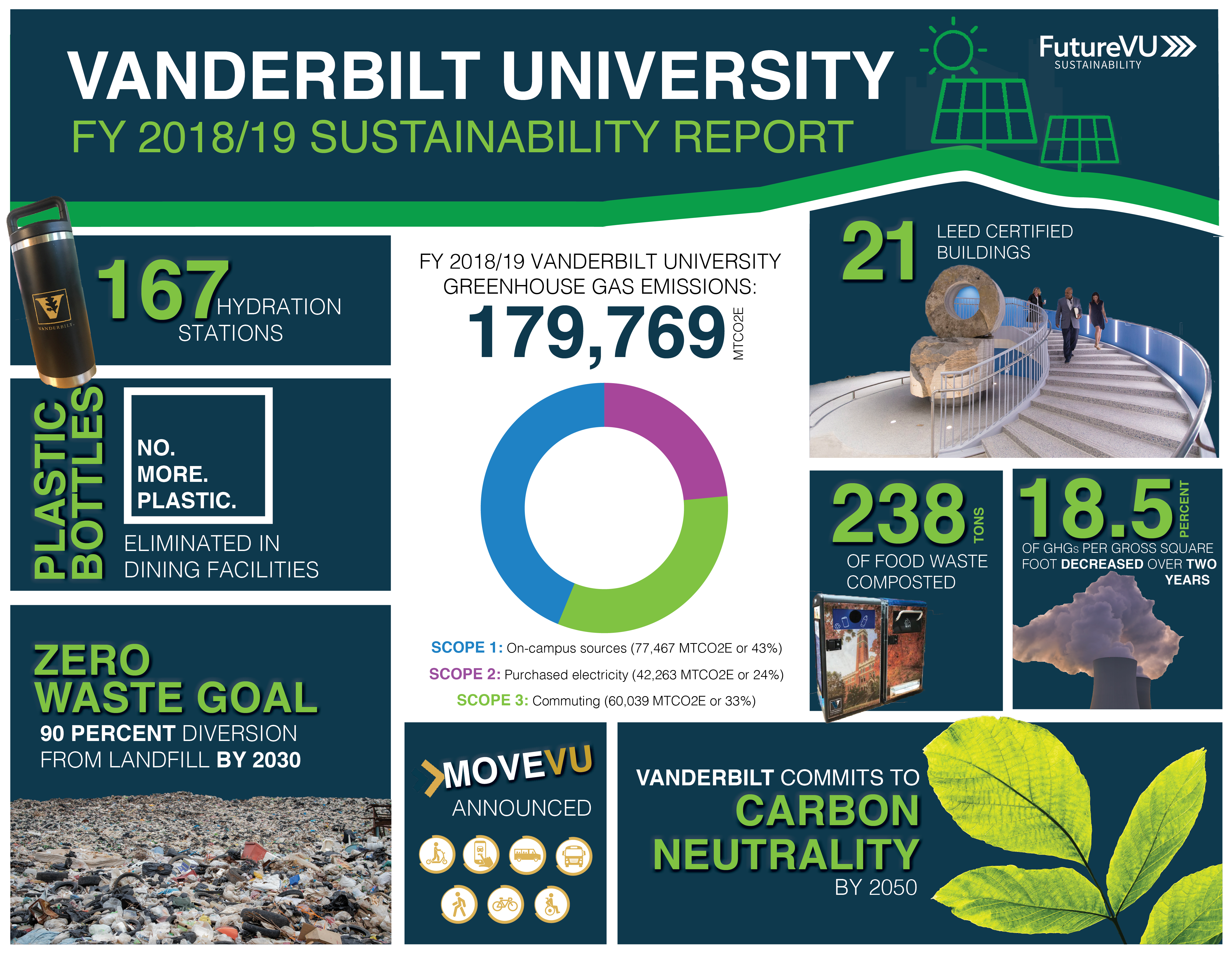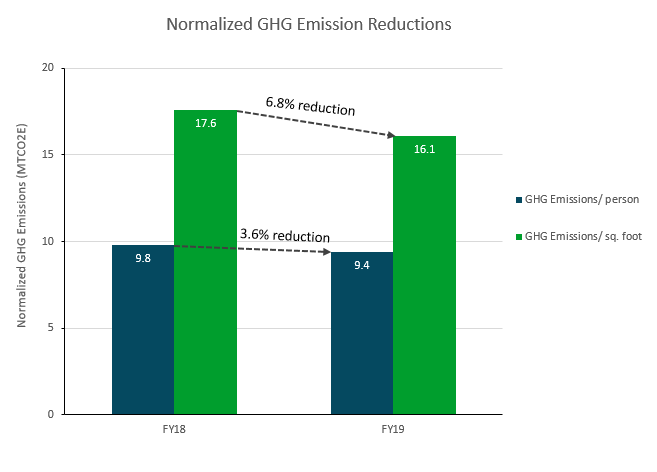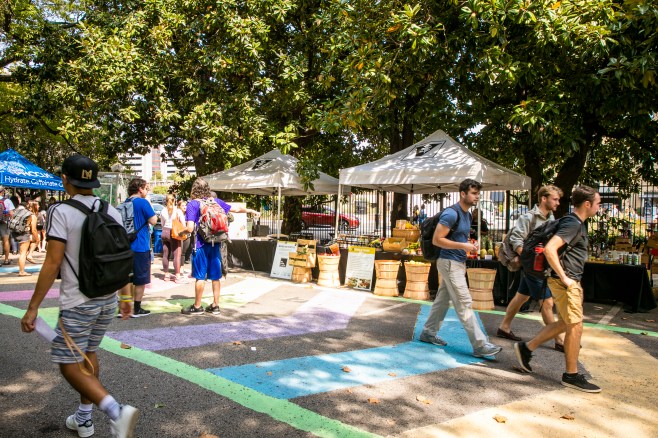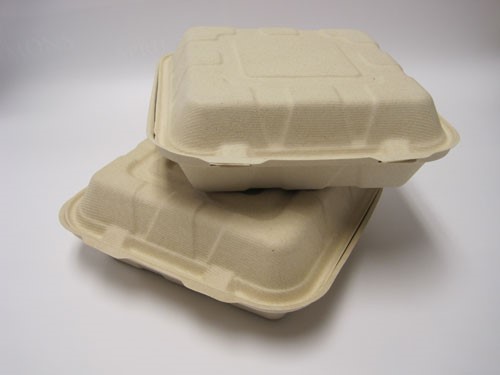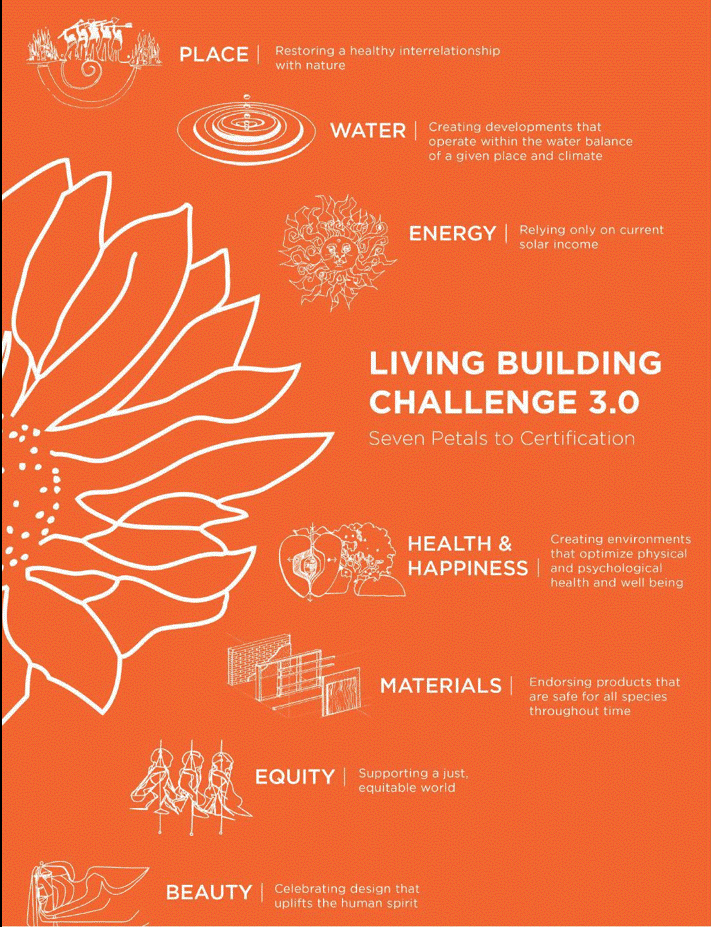Annual Sustainability Report FY 2018-2019
Introduction
A $1 million gift from Commodore Cornelius Vanderbilt in 1873 established the University following the Civil War, with the mission to “contribute to strengthening the ties which should exist between all sections of our common country.” Today, Vanderbilt University is a top-15 private research university offering a full-range of undergraduate, graduate and professional degrees. Vanderbilt is situated on a 333-acre campus near the thriving city center of Nashville, TN, serving over 12,000 students and directly employing more than 6,000 faculty and staff. Its affiliated academic medical center, Vanderbilt University Medical Center (VUMC), is contiguously located and operates in close partnership and through a combined internal power grid with the University.
Vanderbilt University operates an on-site, natural gas fueled co-generation power plant that meets the steam and a portion of the chilled water needs of the University and Medical Center and 33% of the electrical needs. The remaining 67% electrical need is purchased from the Tennessee Valley Authority through Nashville Electric Service (NES). Vanderbilt emits Greenhouse Gases (GHGs) through these two processes as well as university fleet vehicle use, refrigerant releases, faculty and staff commuting to work, air travel paid for by the University, and waste disposal and recycling.
The six GHGs emitted into the atmosphere that comprise the majority of the carbon footprint are: carbon dioxide (CO2); methane (CH4); nitrous oxide (N2O); hydrofluorocarbons (HFCs); perfluorocarbons (PFCs); and sulfur hexafluoride (SF6). The amount of emissions of each gas are converted to a standard unit of measure, or metric tons of carbon dioxide equivalents (MTCO2E) and then summed to determine Vanderbilt’s carbon footprint.
Vanderbilt University embarked on a new journey as an independent legal entity from VUMC on May 1, 2016. Vanderbilt University is now smaller in both number of people and square feet without the Medical Center, and, therefore, so are the 2016, 2017, and 2018 Greenhouse Gas inventories in comparison to previous inventories (2005-2015). Because of the significant shift in GHG footprint due to the new organization, 2005-2015 GHG data will be archived. The 2016 Annual Report contains first year baseline data for the University only, with the 2018 Annual Report presenting only the third year of trending data. Additionally, this report is fiscal year-based reporting for FY18-19 to better align with Vanderbilt’s financial year and academic year cycle.
This sustainability report is intended to portray Vanderbilt’s current carbon footprint as accurately as possible and to highlight other key sustainability gains in fiscal year 2018 from July 2018-June 2019.
This report is developed by the Vanderbilt Sustainability and Environmental Management Office (SEMO). Any questions should be directed to futurevusustainability@vanderbilt.edu.
Carbon Footprint
OUR GOAL
On Earth Day 2019, Vanderbilt University unveiled a comprehensive long-term strategy to significantly reduce its environmental footprint in part by powering its campus entirely through renewable energy, putting the university on track to be carbon neutral by 2050.
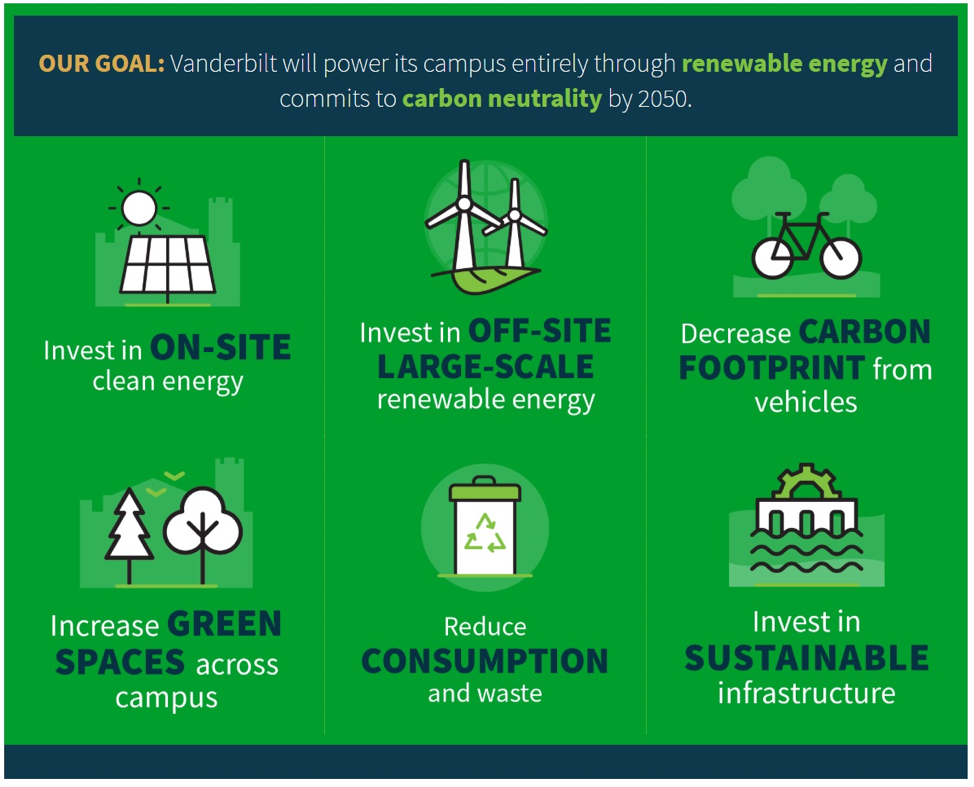
GHG EMISSION SOURCES
Vanderbilt reports greenhouse gas (GHG) emissions across all major sources.
Scope 1: The most significant source of Scope 1 emissions is natural gas use at the on-campus power plant and in individual buildings. Additional Scope 1 emissions include fleet vehicles, diesel use at the power plant, emergency generators, anesthetic gas use, and refrigerant releases.
Scope 2: Scope 2 emissions are entirely from electricity purchased from Nashville Electric Service (NES).
Scope 3: Scope 3 emissions at Vanderbilt include faculty, staff, and student commuting, air travel, waste disposal, and recycling.
More information related to Scope 1 and 2 emissions can be found in the Energy section of this report. Details related to Scope 3 emissions can be found in the Transportation and Waste sections of this report.
GHG EMISSION SCOPES
Vanderbilt University emitted 179,769 metric tons of carbon dioxide equivalents (MTCO2E) in FY18-19. These greenhouse gas emissions were split between Scopes 1, 2, and 3 – 43%, 24%, and 33%, respectively. Scope 1 emissions are direct emissions from sources that are controlled by Vanderbilt, such as combustion of natural gas in the on-campus power plant. Scope 2 emissions are indirect emissions from purchased electricity. Scope 3 emissions are not directly controlled by Vanderbilt but are associated with Vanderbilt, such as employee commuting, air travel, and waste disposal.
Compared to the FY17-18 Greenhouse Gas (GHG) emissions footprint calculation, FY18-19 footprint shows an overall decrease of 2.2% metric tons of CO2 equivalent (MTCO2E). VU’s GHG emissions per gross square foot has dropped by 6.8 % since FY17-18 and 18.4%% compared to CY16, which is a very positive trend. Additionally, the GHG emissions per person decreased 3.6% compared to FY 17-18.
INVEST IN ON-SITE CLEAN ENERGY
BlueSky Vision Energy Strategy Study
The BlueSky Vision Energy Strategy Study was completed in 2018 with the publication of the BlueSky Energy Vision Report. The report identifies major potential opportunities to reduce Vanderbilt’s carbon footprint and improve central campus land use within the University’s on-campus energy production, distribution and consumption infrastructure and behavior. This culminated in a “BlueSky Vision” for campus energy in 2019, detailed below.
Vanderbilt, by the year 2050, will:
- be a leader in energy conservation
- produce on-site clean (without combustion) and renewable energy
- procure off-site renewable energy to mitigate campus greenhouse gas emissions
- store sufficient clean energy to provide campus resilience
ON-SITE SOLAR
A solar-powered hot water heating system is installed in the Currey Tennis Center. Solar panels installed on the roof collect the sun’s energy to heat the water for the building. A 20kW solar panel system is also installed on the roof of Currey Tennis Center. The solar panels generate electricity from the sun’s energy, which is fed into the Vanderbilt electricity grid. A dashboard of the solar panel system can be viewed online with the login: sustainvu@vanderbilt.edu and password: VU*Tennis.
Campus also hosts four solar picnic tables. Each table features a solar array, LED nighttime lighting, four 120 volt and eight USB charging stations, and two large benches for students. The systems will be able to provide 75-100 iPhone charges per day. The tables are installed outside of Kissam Center, Highland Quad, and at the Commons Center.
BEHAVIOR CHANGE
The FutureVU Sustainability Leaders Program, launched in 2019, uses community engagement and peer mentoring to foster a sustainable campus culture, improve sustainability literacy, improve interaction with sustainability initiatives such as Net Zero Energy and Zero Waste, and encourage and enable positive behavior change within campus, student, departmental, administrative, professional, residential, and other VU communities. Sustainability Leaders support Vanderbilt’s carbon neutrality by 2050 goal through culture change, education, peer mentoring, and facilitation of actionable goals.
A collaborative project with the Sustainability and Environmental Management Office (SEMO), Vanderbilt Law School, and Owen Graduate School of Management is researching fume hood use in laboratories on campus to determine what behavioral interventions produce the most energy-saving behaviors in the lab. Each fume hood uses the same amount of energy as a home and VU has over 800 fume hoods. The study has shown that various behavioral interventions such as incentives and competition have a beneficial impact on how often fume hoods were closed.
Invest in off-site large-scale renewable energy
Large-Scale Renewable Energy Study
The Large-Scale Renewable Energy Study, conducted with input from the Large-Scale Renewable Energy Study Advisory Committee, a mix of diverse stakeholders on campus, explored potential options for off-campus, large-scale renewable energy sources, including solar and/or wind projects. The university is currently exploring the potential strategies recommended by the Advisory Committee.
Decrease carbon footprint from vehicles
EMISSIONS SUMMARY
Vanderbilt is a major employer in Nashville. The university consists of more than 6,000 faculty and staff, is home to nearly 7,000 undergraduate students, and is the place of study for an additional 5,700 graduate and professional students. Combined, Vanderbilt’s commuting population is 12,618, which contributes 42,425 MTCO2E to the University’s carbon footprint, or 70.6% of transportation emissions. Air travel for faculty and staff accounts for another 15,193 MTCO2E, or 25.3% of transportation emissions. Transportation emissions are 32.1% of Vanderbilt’s overall emissions.
MOVEVU
MoveVU is Vanderbilt’s strategic transportation and mobility plan that falls under the FutureVU comprehensive campus planning efforts. MoveVU goals align with FutureVU guiding principles to beautify the campus, preserve and enhance the park-like character people enjoy, create a walkable and sustainable campus and better connect areas of campus that feel disconnected. MoveVU calls for diversification of transportation options, reduction of the drive alone rate to campus that aligns with university goals to become carbon neutral, prioritization of pedestrian and micromobility, and improvement of accessibility. The MoveVU plan outlines ways the university can shift its mode share and reduce the drive alone rate to campus. Vanderbilt University’s current drive alone rate is around 76.5%, and the MoveVU goal is to reduce the drive alone rate to 55% by 2025. In order to achieve this goal, the percentage of individuals taking alternative commute modes, such as walking, biking, taking transit, carpooling, vanpooling, and more, will need to increase.
Vanderbilt also participated for the third time in Nashville’s Park(ing) Day, which serves to draw attention to the use of public space in urban areas by temporarily turning parking spaces into parks and parklets. Vanderbilt transformed 40 parking spaces into an interactive parklet that featured games and activities throughout the day in a relaxing environment that included landscaping, hammocks and a water feature.
INCREASE GREEN SPACES ACROSS CAMPUS
A guiding principle of FutureVU is that Vanderbilt resides in a unique and distinctive park-like setting. The plan looks to balance the distribution of open lawns throughout campus through careful evaluation of built and open space targets. To achieve this expansion of green spaces across campus, Vanderbilt has a variety of initiatives underway, including the development of a greenway network, stormwater management practices, a landscape master plan, smart irrigation practices, and green roofs, detailed below.
GREENWAY NETWORK
Connections between neighborhoods are essential to the formation of a coherent campus fabric. The Greenway network will be an organic instrument of connection that establishes recognizable connections between campus places and spaces. Establishing clear and safe connections between neighborhoods will create a more unified and accessible campus, in keeping with the Vanderbilt principles of unity and inclusion.
Principles for the Greenway network have been developed, aligned with overarching FutureVU principles that emphasize the importance of accessibility, inclusivity, and sustainability.
STORMWATER MANAGEMENT
Stormwater management practices are in place across campus. The Engineering Science Building has a cistern that collects stormwater from the roof for irrigation and includes a landscape with bioswales and a green roof to retain stormwater on site. The Commons includes vegetated drainage swales utilizing native plants, reduction in the amount of impervious area (replaced by landscaping), and pervious pavement located around the Martha Ingram Commons. Similar stormwater pollution prevention features were incorporated into Vanderbilt’s newest living-learning community which opened in August 2018, E. Bronson Ingram Hall. Components include vegetated drainage swales and stormwater collection areas (utilizing native plants), a RainBird IQ system, and replacement of asphalt with pervious pavement.
Landscape Master Plan
The Landscape Master Plan was developed to ensure that campus landscapes support the FutureVU principle that Vanderbilt is a university that resides in a unique and distrinctive park-like setting, and seeks to strengthen and expand the university’s aesthetic character. The Landscape Master Plan also supports the FutureVU goal of increasing green space to 50% of more across campus. The university can ensure that future development reinforces the park-like setting through green spaces and pathways by conserving the Vanderbilt Arboretum. In support of this vision, the Landscape Strategic plan sets standards and governance for the campus outdoor spaces. This is accomplished by establishing long-term goals, maintenance standards, record keeping procedures, advisory committee, and targets for the university landscape.
SMART IRRIGATION
One of Vanderbilt’s most significant efforts to conserve potable water is the collection of water from underground utility tunnels, which is used to irrigate sports fields and lawns on campus. In addition, air conditioning condensation collection systems are now in the Commons Center and two of the Medical Research Buildings. The Rainbird IQ irrigation system allows for on-demand, efficient water use.
GREEN ROOFS
Vanderbilt has six green roofs across campus, which provide multiple benefits including reduced energy use in buildings, reduced urban heat island effect, improved stormwater management, increased roof longevity, and improved aesthetics.
Many of the green roofs at Vanderbilt are “hidden in plain sight” and act as plazas or lawns. The newest green roof was installed as a part of a major renovation of Eskind Library. A group of students organized a green roof awareness event in 2017 that led participants through the green roofs across campus to highlight these unique features and share information about the benefits.

Reduce consumption and waste
Zero Waste study and plan
This Zero Waste Study and Master Plan has been developed by the Zero Waste Advisory Committee to address the portion of Scope 3 emissions related to waste disposal and recycling and to help progress towards Vanderbilt’s carbon neutrality goal. Of Vanderbilt’s Scope 3 emissions, waste is responsible for 2,420 metric tons of CO2 equivalent (MTCO2E) or 1 percent of the total GHGs that Vanderbilt emitted in FY2017-18.
Vanderbilt’s history of recycling has expanded in recent years to include food and material waste reduction. The Zero Waste Master Plan continues this forward progress to attain a higher standard of waste prevention, reduction, reuse and diversion. Zero waste is defined by the U.S. Green Building Council (USGBC) as at least 90 percent diversion from the landfill, but it is much more than that. The zero-waste hierarchy includes:
 Redesign – avoid purchasing products/materials or redesign processes or spaces to reduce material use and provide use flexibility.
Redesign – avoid purchasing products/materials or redesign processes or spaces to reduce material use and provide use flexibility.- Reduce – reduce existing waste streams. If waste is not created, the greenhouse gas (GHG) emissions and cost associated with that waste will not occur.
- Reuse – find new ways to reuse or upcycle materials instead of recycling or disposing of them.
- Divert – recycle and compost waste streams when possible to divert waste from the landfill.
- Landfill – landfill remaining waste as the last option.
Based on past data, the Committee recommended that the university consider the following two goals, along with two supporting actions:
GOAL 1: Achieve Zero Waste (90% diversion rate) by 2030
GOAL 2: Achieve 30% waste generation reduction from 2017 levels by 2030
Supporting Actions:
- End institutional single-use plastic purchases by 2025, except in laboratories*; and
- Expand food waste collection to include all dining areas and residential halls by 2025
* Laboratories are exempt due to lack of available alternatives and safety concerns.
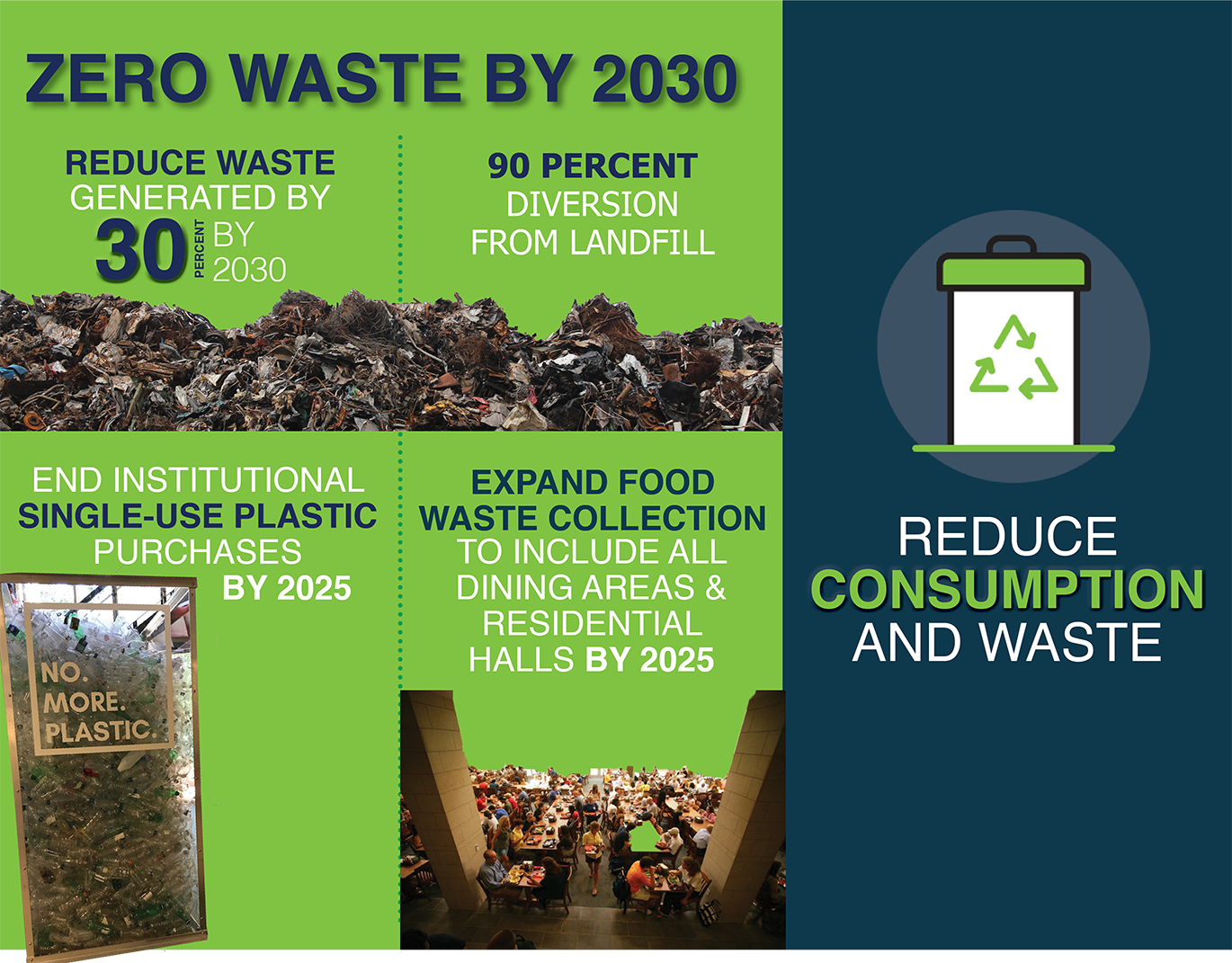
The Committee also examined current waste streams, waste generation activities, existing strategies, challenges and opportunities for improvement throughout campus. Data and feedback were gathered from almost 100 stakeholders through a series of meetings with various groups from across the university. This plan contains suggested paths for reducing or eliminating waste streams, increasing diversion rates with more recycling and food waste collection and reusing or repurposing specific waste streams, as well as strategies for outreach and education.
Campus Waste and Recycling
Vanderbilt has a 30-year history of recycling efforts to reduce waste going to landfills. In addition to traditional recycling programs for materials such as paper, plastic, cardboard, and glass, Vanderbilt has recycling programs for non-traditional materials like construction and demolition debris, toner cartridges, batteries, light bulbs, scrap metal, and electronics. Additionally, the ReUse program that started in 2016 sustainably manages unneeded furniture and equipment owned by Vanderbilt University departments and laboratories. Vanderbilt has also made significant efforts to reduce waste from its dining facilities in the form of food waste reduction, and the reduction of waste from food service.
These efforts are creating major environmental impacts. Vanderbilt sent 9.5% less waste to the landfill from FY 18-19 compared to FY 17-18, and had a diversion rate for the University of 47.4 in FY 18-19.
RECYCLING STREAMS
In 2018, Vanderbilt University generated 6,440 tons of waste and 5,813 tons of recycling. Waste disposal accounts for 2,420 MTCO2E from Vanderbilt or about 1.3% of our total emissions.
Vanderbilt’s 5,813 tons of recycling are broken down into specific streams below.
Single Use Plastic
In line with Vanderbilt’s Zero Waste Plan, and as part of its ongoing sustainability efforts, Vanderbilt University no longer sells single-use plastic water and soda bottles in its dining facilities, markets and vending machines. This move aligns with Vanderbilt’s goal to eliminate single-use plastic purchases by 2025. The collaborative effort involved will reduce plastic waste by more than 430,000 plastic bottles per year and over 1.7 million bottles during a graduating class’s four-year experience. All undergraduate students were given a free, reusable water bottle and there are over 160 hydration stations across campus.
Food Waste Reduction
MINIMIZING FOOD WASTE
Campus Dining has adopted two innovative systems to help reduce food waste. A cloud-based system, known as Fusion, offers a complete food and nutrition solution from menu planning to production, food service operations, purchasing and cost management, and student mobile nutrition information. The second system utilized is a technology called LeanPath. This system tracks all pre- and post-consumer waste as well as composted food waste and records the information in a cloud base system allowing for department wide analytics and waste analysis. LeanPath also helps avoid overbuying and reduce the need for unwanted food donation programs.
Unused food that remains is donated on Second Spoon Food Truck. Started by Vanderbilt football player Mo Hasan, the nonprofit distributes unused food from Dining locations, all from a food truck. The truck allows Second Spoon to mobilize to different corners of Nashville in search of those suffering from hunger.
COMPOST
A program for composting food waste was started in October 2017 in the Common’s Center Dining Hall. The program currently includes pre-consumer collection for all dining prep locations, as well as post-consumer collection at Rand dining hall and the Commons Center dining hall. Food waste is collected and composted by the Compost Company, a local vendor. In addition to food composting, all to-go food containers, cups, flatware, and straws offered are made out of compostable materials.
Composting is a process in which organic waste is broken down into a rich, soil additive under controlled conditions. Compost can be used to promote plant growth while also reducing landfill waste by recycling organic materials back into the soil. The compost program will be expanded to include all dining locations in the future to support Vanderbilt’s Zero Waste Plan.
Sustainable Food Practices
Sustainable Dining
VU Campus Dining supports the well-being of diners and the health of our environment. Dining’s sustainability program is designed to give diners information about Vanderbilt’s kitchen principles and how they affect your environment, community and well-being. VU is also a member of the Menus of Change University Research Collaborative (MCURC). MCURC is a working group of leading scholars, foodservice business leaders, and executive chefs from invited universities who are accelerating efforts to move Americans toward healthier, more sustainable, plant-forward diets.
Principles of sustainable dining that are in place currently include:
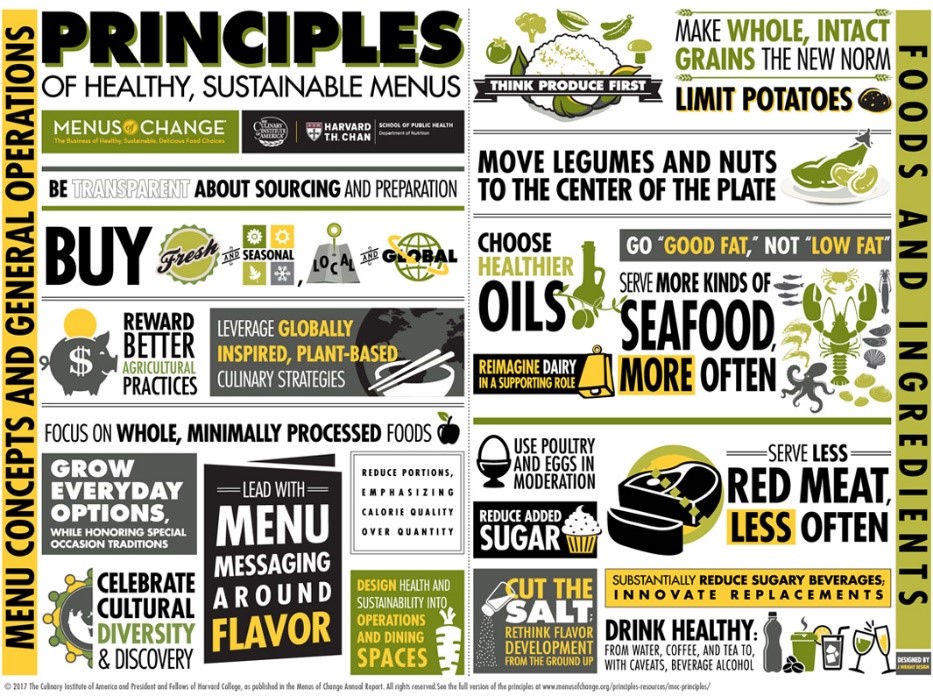 Serving more kinds of seafood, more often.
Serving more kinds of seafood, more often.- Substantially reducing sugary beverages with innovative replacements
- Adding hydration stations across campus
- Reducing soda options in fountain machines
- Adding sparkling water dispensers and more tea options
- Serving less red meat, less often.
- Reducing number of times beef is offered while increasing seafood and vegetarian options
- Serving burgers across campus that are 75% beef and 25% mushrooms.
- Offering the Impossible Burger (plant-based option) at our burger stations.
- Using poultry and eggs in moderation.
- Serving only cage-free eggs across campus.
- Reducing portions.
- Emphasizing calorie quality over quantity.
SUSTAINABLE PURCHASING
Vanderbilt is exploring a Sustainable Purchasing Policy that establishes standards for the purchase of goods and services consumed by the University with the goals of:
- Reducing the environmental footprint of the University’s operations
- Leveraging Vanderbilt University’s purchasing power to encourage transparency and environmentally friendly manufacturing practices within product industries
- Influencing generations of environmentally conscious product users through educational programs and by example
If two products are competitive in performance characteristics and pricing, the University will favor the environmentally preferable product or supplier. For example, Vanderbilt’s Purchasing and Payment Services has worked closely with the University’s preferred suppliers of office products, janitorial products, and laboratory products to provide more easily identified environmentally preferable product selections. These products are readily identifiable in eProcurement by a special symbol. Purchasing and Payment Services partners with suppliers that are committed to sustainability practices and offer the Vanderbilt community products like FSC recycled paper, remanufactured toner cartridges, and EnergyStar or EPEAT electronics.
The Sustainable Purchasing Policy will enable Vanderbilt to plan its future growth in balance with economic, environmental, and socially responsible values.

GREEN PRINTING
The Vanderbilt CampusPrint initiative is a multi-phase program to switch to energy efficient printers, reduce the amount of printing, and use more sustainable paper.
Since the launch of CampusPrint in 2017, 426 desktop printers/fax machines were eliminated across campus, significantly reducing the overall printing across campus. Multi-function devices replaced any remaining printers that were still necessary.
The EPA estimates that one page printed using a personal desktop printer costs up to 14 times as much as one page printed using a multi-function unit. Additionally, each ton of office paper consumes 12,000 gallons of water, 24 trees, 98 tons of various materials, and 11,000 kWh to produce, creating one ton of solid waste and 15,000 gallons of waste water in the process.
Many green paper/printing options are available to the Vanderbilt community, including post-consumer waste recycled-content papers, papers certified by the Forest Stewardship Council (FSC), vegetable-based inks, papers processed without chlorine, and products made with renewable energy. In collaboration with SEMO, VU Printing Services achieved Forest Stewardship Certification as an environmentally sustainable printer, and all CampusPrint paper is FSC certified.
Invest in sustainable infrastructure
ENERGY – EFFICIENCY PROJECTS
Greenhouse gas emissions normalized on a square foot basis have dropped more than 18.4% since 2016 and 7% since 2017 due to a combination of ongoing energy efficiency improvements of existing buildings by Plant Operations and green building techniques employed in new construction by Campus Planning and Construction. These building practices are described in the Sustainable Infrastructure section below.
LEED
Vanderbilt has a long history of building with sustainable and green features, which are more efficient and last longer. The U.S. Green Building Council’s Leadership in Energy and Environmental Design (LEED) Green Building Rating System is the nationally accepted benchmark for the design, construction, and operation of high-performance sustainable buildings. This third-party certification is recognized as confirmation that a building is environmentally responsible. LEED projects earn points across nine categories: integrative process, location and transportation, sustainable sites, water efficiency, energy and atmosphere, materials and resources, indoor environmental quality, innovation, and regional priority.
Vanderbilt University has a total of 21 LEED certified projects and was the first university in Tennessee to earn LEED certification.
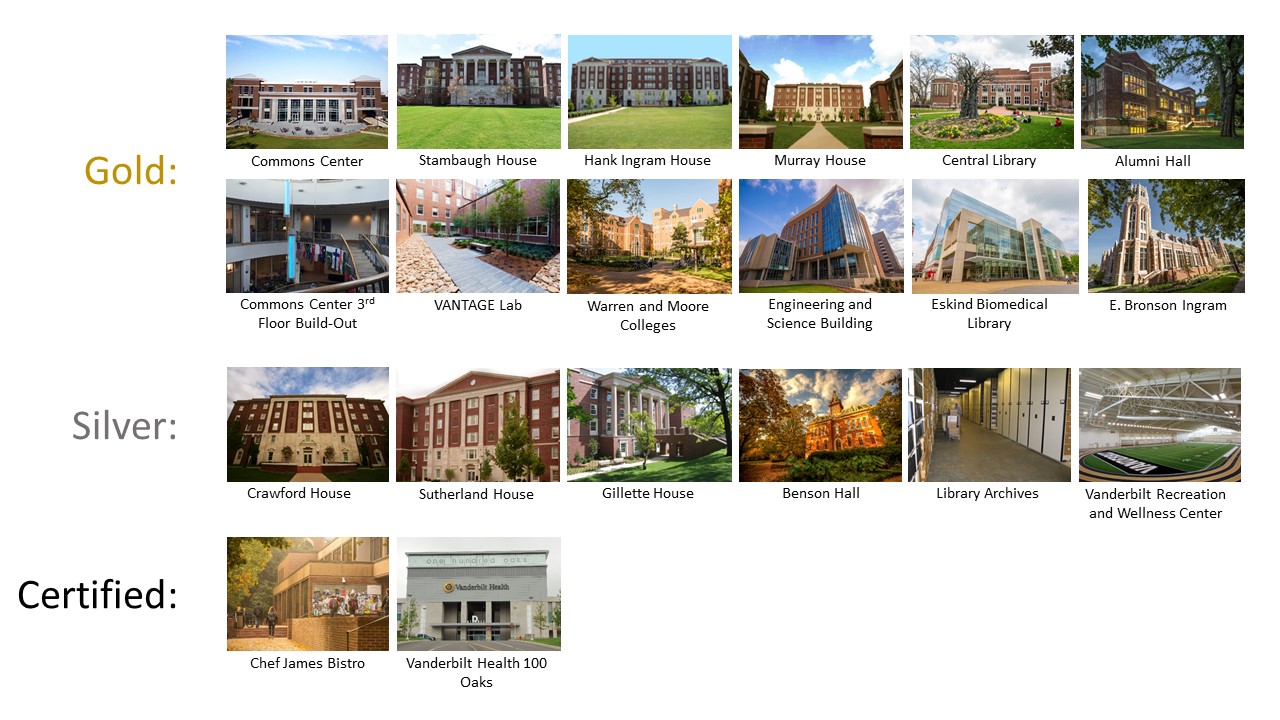
Well
Looking forward, Vanderbilt will explore other certifications for sustainable buildings in addition to LEED. The School of Nursing building expansion is Vanderbilt’s first WELL certification pilot, in addition to pursuing LEED Gold. WELL certification serves as a credible label for a building’s effect on occupants’ health and well-being.
Living Building Challenge
Vanderbilt is also exploring the Living Building Challenge certification, which certifies buildings that are regenerative and positively impact the environment. Vanderbilt’s first petal certification pilot is planned for the Peabody Home Economics and Mayborn Hall building complex, which is pursuing the materials petal. The intent of the Materials Petal is to help create a materials economy that is non-toxic, ecologically restorative, transparent, and socially equitable.
WATER
Vanderbilt has taken significant steps to reduce its water usage. Since 2007, Plant Operations has retrofitted 3,500 bathroom fixtures on campus in an effort to make them more water efficient. These efforts include low flow and no touch faucets, low flow and dual flush toilets, high-efficiency showerheads and water free urinals.
Green Cleaning
Vanderbilt is expanding the use of green cleaning products and practices throughout VU Facilities as part of its focus on WELL building principles. VU is implementing a Green Cleaning Policy requiring:
- Each building to have an individualized Green Cleaning plan
- Campus cleaning practices to be tracked
- The use of pre-approved cleaning products and equipment
- Routinely providing education on best practices, new technologies, and procedures for cleaning
- Policy revisions every five years
ENGAGEMENT AND EDUCATION
FutureVU Sustainability acts as the sustainability information hub for Vanderbilt University. Together with the FutureVU Sustainability website, newsletter, social media, and in-person education and training, FutureVU Sustainability has had the following engagement impact:
Green Fund
OVERVIEW
The Vanderbilt Green Fund (VGF) provides funding specifically to projects that are student-initiated and reduce the greenhouse gas emissions or improve the overall sustainability of the Vanderbilt University campus. VGF enables students, faculty, and administration to directly engage in the process of transitioning to a clean and sustainable energy future. Any student, faculty, or group associated with Vanderbilt University can propose a project for consideration.
The Office of Housing and Residential Education and Plant Operations make a combined annual input of $150,000 to the VGF. Green Fund proposals are first evaluated by a student committee that is organized jointly by VSG and SPEAR. Top proposals are recommended by the student committee to the Green Fund Working Group, which makes the final funding decisions. The Working Group is comprised of six administrators, six students, and one faculty member. To propose a project to VGF, complete this application.
Reusable cups and plates
The Vanderbilt Green Fund and Campus Dining now offer rentable plates and cups for Vanderbilt students, staff, and faculty to rent for meetings and events. Lightweight plates and cups can be checked out from Rand Dining Center, used for the event or meeting, and returned to the dining center to be washed and ready for the next checkout. This reduces the need for campus groups to use disposable materials, reducing Vanderbilt’s waste consumption. Email campus dining to request these items for your next event!
PAST REPORTS
Vanderbilt is committed to the highest standards of transparency and sustainability through a process of environmental responsibility and accountability at every level of the University. With regards to climate change, this commitment translates to actions aimed at reducing greenhouse gas (GHG) emissions at the university, departmental, and individual level.
The completion of a university-wide GHG emissions inventory has occurred annually since the first publication in 2005. These reports provide many key data points, past trends and successes of Vanderbilt University and its efforts to curb greenhouse gas emissions and operations.
The listing to the right provides downloadable files of our past greenhouse gas inventories and reports.
From 2008 to 2015, Vanderbilt University, including Vanderbilt University Medical Center, reduced its overall greenhouse gas emissions by 27%. In 2016, the University separated from the Medical Center, resulting in changes to its boundaries, operations, and size of population, which necessitated a new 2016 baseline.
- FY 2017-2018 Annual Sustainability Report
- 2016 Annual Sustainability Report
- 2015 Greenhouse Gas Emissions Inventory Update,
Published October 2016 - 2014 Greenhouse Gas Emissions Inventory Update,
Published October 2015 - 2013 Greenhouse Gas Emissions Inventory Update,
Published October 2014 - 2012 Greenhouse Gas Emissions Inventory Update,
Published October 2013 - 2011 Greenhouse Gas Emissions Inventory Update,
Published October 2012 - 2010 Greenhouse Gas Emissions Inventory Update,
Published October 2011 - 2005-2009 Greenhouse Gas Emissions Inventory Update,
Published October 2010 - 2005-2007 Original Greenhouse Gas Emissions Inventory
Contact
Andrea George, PhD, CHMM, PMP
Director
Phone: (615) 322-4551
Email: andrea.george@vanderbilt.edu
Alexandra Ewing, PhD, LEED GA
Assistant Director
Phone: (615) 343-3931
Email: alexandra.b.ewing@vanderbilt.edu
Steve Gild, MS, CHMM
EMS Coordinator, Senior Safety Officer
Phone: (615) 322-3745
Email: steve.gild@vanderbilt.edu
Chelsea Hamilton, MS, LEED AP
Sustainability Outreach Coordinator
Phone: (615) 322-9022
Email: chelsea.l.hamilton@vanderbilt.edu
Sustainability and Environmental Management Office
Email: futurevusustainability@vanderbilt.edu
Mailing Address: 2043 Scarritt Place, Nashville, TN 37240-07761

